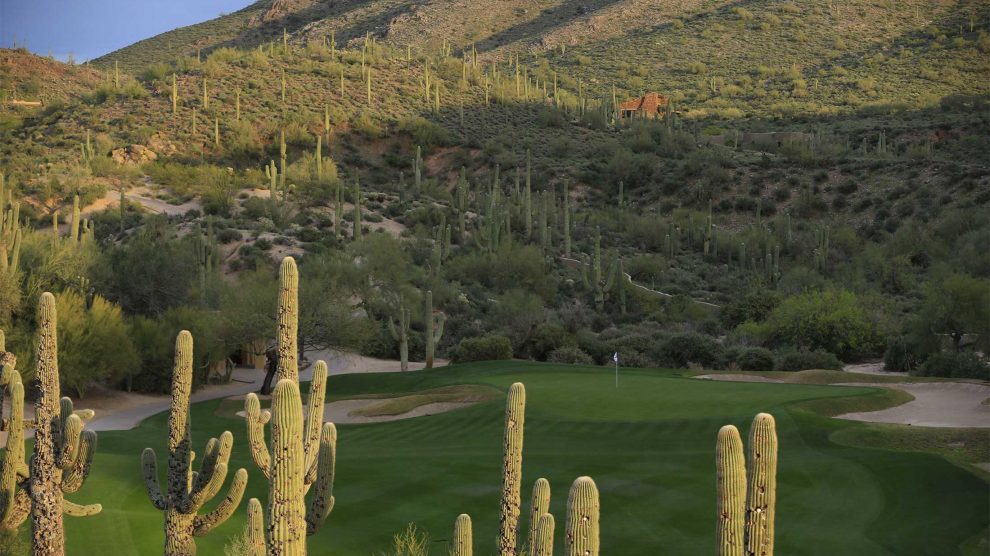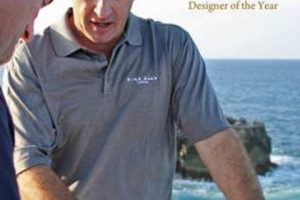Tom Weiskopf has experienced all corners of the game, from his time as a PGA Tour player – his 16 career titles included the 1973 British Open at Royal Troon – to his work as a golf course designer. Weiskopf, 78, recently talked with Golfweek about both sides of the game.
In Part I of this Q&A, which you can read here, Weiskopf discussed the recent Masters, Dustin Johnson and Rory McIlroy, playing with Ben Hogan and how he lost his gig broadcasting the Masters on CBS.
Now, in Part II, Weiskopf remembers his first design project, Troon Country Club in Scottsdale, Arizona. No architect forgets their first foray into the business and here Weiskopf delves into his design. philosophy, his entry into the business and his various partnerships and influences.
Golfweek: How did you become interested in pursuing a career in golf course architecture?
Tom Weiskopf: I got invited by Jack Nicklaus to go on some site visits with him. As architects, we’re not always sure of the strategy on a hole at the outset and I kept getting asked, “Tom, what do you think?” One or two my suggestions got used and it gave me confidence that an opportunity might happen for me someday, and it did.
GW: Had you been looking to enter the design field, or was your involvement at Troon Country Club, your debut project, a happy accident?
TW: Jerry Nelson, a developer in North Scottsdale, called me up and asked me to look at a piece of property. It was 1982 and he had already done a development around Pinnacle Peak Country Club and was quite successful. He wasn’t a golfer and admitted that rightfully so, and everyone told him he needed a name to design the course.
I was living in Scottsdale at the time. I told him, I wouldn’t look at it that way. I’m not qualified, but I’ve played a lot of the great golf courses in the world. He said, “But you’re local. Would you be interested?” I called up Jay Morrish, who had been Jack Nicklaus’s chief designer. I had heard he’d left Jack’s camp and asked him to look at the property with me. He came out and said, “I’d partner with you, Tom.” And that’s how it started – being at the right place at the right time and presented with an opportunity.
It became evident that I had the technical experience I needed in the form of Jay and off we went. Of course, it became a learning experience in regards to me in terms of the routing, how important that is and the construction and capability of the equipment and the communication aspect with the shapers and building and preparing a hole for a golf course. I made a decision. I had a pretty good career going and a handful of contracts but I thought why don’t I take a year off from playing and see if I like it. I never went back to playing.
It helped to have that golf course win the best new private golf course in the country from Golf Digest. It gave us instant credibility as a team.
Troon Country Club in Scottsdale, Arizona, a Jay Morrish and Tom Weiskopf-designed golf course. (Photo by Troon Country Club)
GW: What contributions did each of you make in the design?
TW: Jay allowed me to do the strategy, where the bunkering should be, the size and shape of the green, and he put that in a drawing form. I actually walked it one day when we had it staked and I called Jay up late in the afternoon before we started construction and I said, ‘We ought to reverse the routing of the front nine.’ He said, ‘Let me come out there and let’s walk it together and you tell me why.’ I explained it to him and he said, ‘I think you’re on to something.’ We spent two days throwing it back and forth and Jay finally said I think you’re right, and we agreed to go with my idea.
GW: Jack Nicklaus’s Desert Highlands had opened a few years earlier just down the street. It possessed some innovative features and a wild set of greens. Not far away was the original desert target layout, the low-profile Desert Forest, where you were a member and a big fan. How did each course influence the design of Troon Country Club?
TW: I think I have a much different philosophy in strategy than Jack does in regards to green layouts. Jack does a lot of lateral presentation. Take the 12th hole at Augusta. It’s a one-club situation. You have to go over a water hazard and it’s a very narrow target. I like the basic MacKenzie philosophy of having the green open in front with the penalty more on the sides. The greens would tilt slightly right to left or left to right. Instead of having to hit one club the right distance and control that distance, you have more versatility where you can run it up if you choose. You bring more of a two-club or three-club aspect for your second shot to a par 4 with a green by length and depth to it than perpendicular to the line of play.
Jack has a lot of that at Desert Highlands. Then you look at Red Lawrence who did Desert Forest. His were more traditional with round greens and longness to them, tilting one way with the penalties on the side. I always enjoyed playing it. That was the difference to the two. My philosophy was very different than Jack’s, thank goodness. Jack uses a lot more bunkers than I do, always has. MacKenzie’s famous quote is there should be one bunker in the tee shot landing area and one around the green that must be avoided at all cost. It’s a great quote. I liked strategically placed bunkers.
GW: Troon included a drivable par 4. Were you already thinking of emphasizing that design feature?

Tiger Woods with Tom Weiskopf in the background, during the Champions challenge at the 144th Open Championship at The Old Course at St Andrews. (Photo: Ian Rutherford-USA TODAY Sports)
TW: I told Jay the things that I thought were important for a golf course. When I said we needed a drivable, he said, ‘What are you talking about?’ I go back to the first time I played St. Andrews. I think it was 1970 and I drove the ball on the green at 9, 10, 12 and 18. I never did it on the same day because they were all at different directions. I think it should be no different than a reachable par 5. I told him I want to put a reachable par 4 on all of our golf courses. He said it was a great idea. Anyway, the fourth hole became our drivable. I’ve put at least one if not two at all of the 73 golf courses I’ve done. I think it works best at the 16th or 17th hole. You don’t always pull them off. I would say three-fourths of them are in the 300-330 yard range. It just hit me when I played St. Andrews. These days, it seems to be the flavor of the month. But it’s a hard hole to do right and to make it exciting.
GW: Two of the most memorable holes at Troon CC are the par 3s on the back nine. Did you just see them or did you have to move a lot of land?
TW: The one hole we contrived was 13. There was a lot of fill-in there. We filled a valley. It’s an homage to the Postage Stamp [at Troon in Scotland] but it plays a lot longer than the original. It plays 175-180. At 15, Jay found an area where we could fit a green in there. We had all the beautiful boulders around it. It’s a rendition of the 7th at Pebble. It’s a small green surrounded by bunkers.
GW: In between those two par 3s is a wonderful par 4 fittingly called “Cliff,” where the fairway abruptly ends at the edge of a veritable cliff, setting up a dramatic downhill shot to the green. What was your inspiration for that hole?
TW: That’s a rendition in a way of the 8th at Pebble. You go downhill about 80-100 feet. You’re given things on a property that remind you of certain holes that you’ve played. I try to duplicate some of the qualities but never identically.
GW: What do you consider to be Troon CC’s signature hole?
TW: You’d have to say 15, the little 3 with the boulders and you’ve got the big mountain there and you can see Pinnacle Peak in the distance way to the left. It kind of defines the area. But I don’t like that term “signature hole” for one reason. If everybody is talking about only one hole, you didn’t do a very good job, did you?
GW: What happened to your partnership with Jay Morrish?
TW: He wanted to bring his son into the business and I didn’t feel comfortable with doing that and decided to go my own way. We got along great and did 25 wonderful courses together. I didn’t want to expand. Our basic philosophy was we were available for 2-3 projects per year. We were a hands-on boutique design company and he wanted to get bigger and I didn’t. He understood that when we parted. He was great. Everything that I learned about this business I give him credit for. He was very knowledgeable and good at what he did.
GW: What is it like to get a second bite at the apple so-to-speak all these years later at Troon?
TW: We didn’t change anything dramatically. We took a few bunkers out that were by request of the membership because they were too deep. There was no need to change anything other than the surface of the greens, level the tees, improve the drainage and improve the playability of the golf course as best you can.
We remodeled the entire bunker complex by flashing the sand up. Before we had a semi-Donald Ross look, where we had grass face coming down and you didn’t expose a lot of visibility of sand up on the slope faces. We got white sand, too, and it’s much more playable and dramatic looking. We went to a more MacKenzie style where it flashes all the way up to the top of the bunker next to the green like a wave breaking. I’m a big believer in the MacKenzie philosophy of bunkering – they are used for strategy and must be avoided; for direction, where you play over them like No. 10 at Augusta; or to be helpful, where they are used to keep you from going into a worse position.
Our philosophy from the beginning was if we gave 100 percent for the client we won’t have to change anything over time other than the additional tees for distance, add a bunker here or take one out. We never had to re-do a green because it was too severe and never had to change much of a hole over 34 years of time because we spent enough time during construction to do it right the first time.
GW: Golf course architects never retire, Robert Trent Jones II likes to say, they just stop flying places. How much longer do you plan to do this?
TW: I believe that you’ve got to be involved and you have to want to do it and have a passion for it. As long as I have that, I will stay involved. I like the restoration – it’s not a remodel, it’s a restoration – all we did was make Troon aesthetically different while maintaining the strategy. We didn’t make it easier or harder. It’s given a lot of enjoyment to people. They like it and we didn’t need to change it.
We have a job in St. George, Utah. It’s in a lava field. It’s a growing area and destination. We also have one in Boise, which is another hot spot in the west. There’s a couple other we’re talking about, including one in Scotland that we started long ago and we’re talking to the new owners. A contract hasn’t been signed yet, and we’re talking about some other work in Vietnam. We’re only going to do what Phil Smith and I can handle. He’s my replacement for Jay Morrish and he’s excellent. It’s all about attention to detail and being on the job and giving what they deserve. As long as I maintain that interest, I will stay involved.
The article "Tom Weiskopf Q&A: Remembering his first design at Troon CC" was originally published on https://golfweek.usatoday.com/2020/11/29/tom-weiskopf-q-and-a-golf-course-design-troon-country-club/





